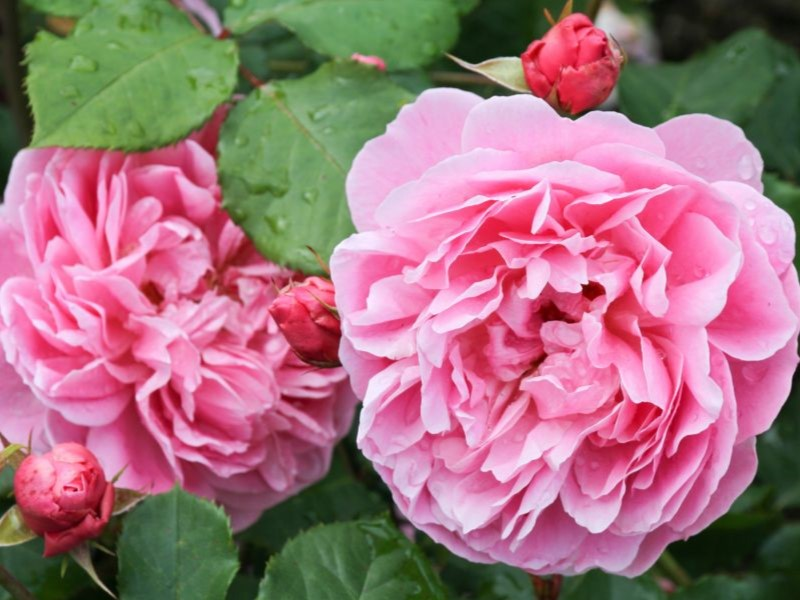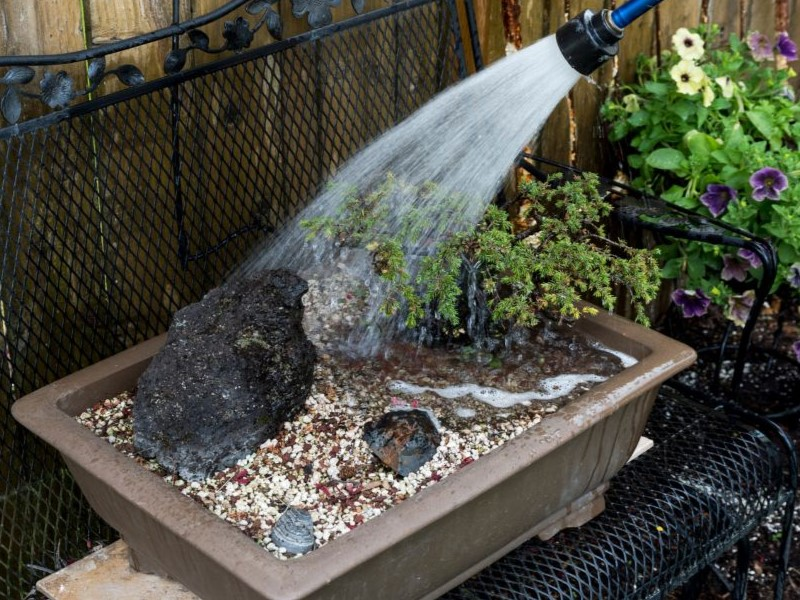Growing a bonsai rose is a delightful blend of gardening and creativity. You get to shape these little trees, prune them just right, and witness the joy of tiny roses blooming in a space-friendly manner.
They are tiny works of art growing on petite trees that you can nurture at home. It’s like having your little garden of blooming wonders on your windowsill or balcony.
So, if you’re up for a small-scale adventure with floral rewards, let’s learn more about these below!
The Art of Bonsai Roses

Roses as bonsai are like little living sculptures, bringing the grace of full-sized roses into a compact form. Imagine a tiny rose tree carefully cultivated to capture the essence of its larger counterparts. The art of it lies in understanding their unique features.
Look closely at a rose plant, and you’ll notice its charming miniature blooms. These tiny flowers boast the same delicate petals as regular roses but on a smaller scale. The texture blends softness and intricacy, offering a tactile experience as you run your fingers over the miniature leaves and blossoms.
Now, onto the leaves- roses showcase petite greenery that mirrors the characteristics of larger rose bushes. The artistry comes into play when you learn to prune these leaves thoughtfully, creating a balanced and visually appealing composition.
Some roses also have rose hips, formed after the blooms have faded. These small, round, berry-like structures add aesthetic appeal and contribute to your bonsai rose’s overall health. Rich in vitamins and antioxidants, rose hips enhance the resilience of your miniature masterpiece.
But their distinct focus on flowering sets roses apart from other bonsai trees. While traditional bonsai trees emphasize the overall shape and structure, bonsai highlight the art of blooming. It’s a unique expression within the bonsai world, where the challenge is to balance cultivating a petite tree with encouraging vibrant and frequent blossoms.
Benefits of Growing Roses
Growing a rose bonsai is more than just a visual treat; it offers a range of benefits that extend into our daily lives. These petite floral wonders delight any space, turning balconies, windowsills, or even desktops into blooming gardens. Beyond the visual appeal, nurturing roses becomes a therapeutic journey, relieving stress as their delicate beauty unfolds. The satisfaction from seeing these miniature roses thrive under one’s care fosters a unique sense of accomplishment, boosting confidence in gardening skills.
Perfect for those with limited space, bonsai trees allow space-friendly gardening, making it accessible for apartment dwellers or those with modest outdoor areas. Beyond the tangible benefits, caring for bonsai offers a direct connection with nature, creating an intimate experience that involves observing seasonal changes, feeling the textures of leaves, and appreciating the unfolding beauty within a confined yet vibrant space. It’s not just about growing plants; it’s an educational experience that teaches patience, an understanding of plant life, and the impact of various care practices. Additionally, a rose as a bonsai is a unique gift option, offering a living, growing present that carries the personal touch of care and attention.
Getting Started: Essential Tools and Materials
For tools and materials, let’s keep it simple and practical, focusing on what you’ll need to nurture these miniature floral wonders.
Start with a healthy young bonsai rose sapling, ensuring it boasts a sturdy trunk and vibrant green leaves. This serves as the foundation for your blooming masterpiece. This bonsai thrives in well-draining soil, so opt for a bonsai soil mix or create your own by combining regular potting soil with perlite or sand, ensuring proper root aeration.
When choosing a bonsai pot, go for a shallow one with drainage holes to prevent waterlogged soil, allowing the roots to breathe. The size of the pot should complement your bonsai sapling. A good pair of pruning shears is essential for shaping and maintaining your bonsai. Look for sharp, clean-cutting shears to ensure precise pruning without causing stress to the plant.
Roses prefer consistent but moderate watering, so a small watering can or misting bottle will help you control water distribution, preventing overwatering or underwatering. Opt for a balanced liquid fertilizer suitable for flowering plants. Feed your bonsai during the growing season (spring through early autumn) to support healthy growth and vibrant blooms.
For shaping purposes, soft, aluminum bonsai wire is handy, allowing you to guide the growth of your bonsai while maintaining its natural appearance. Optionally, consider having a few training pots on hand for the initial stages of shaping, allowing the roots and trunk to develop before transferring your rose to its final pot.
Choosing the Right Species

When venturing into bonsai cultivation, varieties must be particularly well-suited for bonsai enthusiasts due to their inherent features, such as smaller flowers, leaves, and delicate twigs.
Here are some options for various bonsai species:
Rambling Rose (Rosa banksiae alba)
- Characteristics: Known for its cascading growth, this rambling rose showcases small, white flowers and glossy green leaves, making it an appealing option for bonsai styling.
- Bonsai Care: Ensure well-draining soil and adequate sunlight. Prune to maintain its cascading form and remove dead or unwanted growth regularly.
Rose (Rosa canina)
- Characteristics: Also known as the dog rose, Rosa canina, with its pink or white flower and distinctive red hips, presents a natural and bushy growth pattern suitable for bonsai styling.
- Bonsai Care: Regularly prune to maintain shape and remove deadwood. Ensure proper winter protection in colder climates, and fertilize sparingly during the growing season.
Fairy Rose (Rosa ‘The Fairy’)
- Characteristics: ‘The Fairy,’ a dwarf cultivar, features small, double pink flowers and a compact growth habit, adding an enchanting touch to bonsai compositions.
- Bonsai Care: Provide well-draining soil, regular watering, and occasional pruning to shape and promote new growth. Fertilize during the growing season.
Chinensis Rose (Rosa chinensis)
- Characteristics: Boasting historical significance, the Chinensis Rose offers single or semi-double flowers in various colors. Its smaller size and elegant branches make it an ideal candidate for bonsai.
- Bonsai Care: Maintain well-draining soil, shape through selective pruning, and provide balanced, solid organic fertilizer during the growing season. Protect from extreme weather conditions.
Golden Wings Rose (Rosa ‘Golden Wings’)
- Characteristics: ‘Golden Wings’ is a cultivar admired for its golden-yellow blooms. With a more compact growth habit, it lends itself well to the artistry of bonsai design.
- Bonsai Care: Ensure well-draining soil, regular pruning for shape, and provide a balanced liquid fertilizer during the growing season. Protect from harsh winter conditions.
Hybrid Tea Roses:
- Characteristics: Known for immense, classic blooms with a high-centered shape, hybrid tea roses are often considered the epitome of elegance. They come in various colors, each petal exuding a refined beauty.
- Bonsai Care: Hybrid tea roses require diligent care, especially in colder climates. Winter protection is essential to shield them from harsh weather conditions. Regular pruning is recommended to maintain their desired shape and promote new growth.
Soil and Potting Techniques
For effective bonsai care, use well-draining soil by combining regular potting soil with perlite or sand. To support nutrient absorption, maintain a slightly acidic to neutral pH, ideally between 6.0 and 7.0. Integrate regular repotting into your routine, typically every two to three years during early spring. This practice refreshes the soil, provides essential nutrients, and prevents root congestion, ensuring a conducive environment for the health and growth of your bonsai.
Pruning and Shaping
Pruning and shaping are vital for your bonsai roses’ health and visual appeal. Regular pruning controls size and promotes a balanced appearance. Use sharp shears to remove dead or diseased branches, trim disruptive ones, and encourage outward growth. Shape the bonsai, considering the natural growth pattern for a balanced silhouette. Avoid excessive pruning to prevent stress. These simple techniques contribute to the beauty and longevity of your bonsai.
Watering and Care Tips
To ensure the overall well-being of your bonsai rose plant, meticulous attention to watering and care is essential. Consistency is vital, so regularly check the soil’s surface and water when it feels slightly dry. Utilize a small watering can or misting bottle to control water distribution, preventing the pitfalls of overwatering or underwatering. Bonsai thrives in well-draining soil, making it imperative to avoid waterlogged conditions. Tailor your watering frequency to the specific needs of your bonsai variety.
In addition to watering, remain vigilant against pests or diseases by conducting regular inspections and addressing any issues promptly. Provide a balanced liquid fertilizer to support healthy growth and vibrant blooms during the growing season.
Consider incorporating air layering into your care routine for those looking to rejuvenate or shape their bonsai. This technique involves encouraging roots to form on a branch before detaching it, facilitating the development of a more robust bonsai structure. Incorporating these practices will contribute to your bonsai roses’ overall health and vitality.
Common Challenges and Troubleshooting

Encountering challenges with your bonsai is a common aspect of cultivation, but addressing them effectively is vital to maintaining their health. One prevalent issue is overwatering, leading to root rot. To troubleshoot, ensure proper drainage in the soil, and adjust watering frequency based on the specific needs of your bonsai. Another challenge may involve pests like aphids or spider mites. Combat these by regularly inspecting the leaves and using a gentle insecticidal soap or neem oil. If the leaves turn pale, add extra iron fertilizer for a nutrient boost. If your bonsai exhibits stunted growth, reassess its sunlight exposure, ensuring it receives the right amount for its species.
Also, be mindful of potential challenges like powdery mildew- which appears as a white, powdery substance on the leaves, often inhibiting growth and affecting the overall health of your bonsai. If that occurs, apply fungicidal spray, improve air circulation, and consider preventative treatments during high humidity.
Conclusion
Cultivating rose bonsai plants provides a unique and rewarding gardening experience. These miniature living sculptures, showcasing charming blooms and graceful forms, add a touch of natural beauty to your home. Understanding the artistry of bonsai and embracing their benefits, from therapeutic joys to space-friendly gardening, makes this journey both fulfilling and educational.
With essential care tips tailored for roses, you can nurture these tiny wonders and witness the joy of vibrant and frequent blossoms. Overcoming challenges, such as avoiding overwatering, full sun, and addressing pests, fosters resilience in your bonsai.
So, as you embark on or continue this small-scale adventure with big floral rewards, may your roses bring tranquility and delight to your living space!






0 Comments